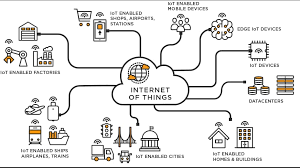IoT
The Internet of Things (IoT) describes the network of physical objects—“things”—that are embedded with sensors, software, and other technologies for the purpose of connecting and exchanging data with other devices and systems over the internet. These devices range from ordinary household objects to sophisticated industrial tools. With more than 7 billion connected IoT devices today, experts are expecting this number to grow to 10 billion by 2020 and 22 billion by 2025. Oracle has a network of device partners.
The idea of adding sensors and intelligence to basic objects was discussed throughout the 1980s and 1990s (and there are arguably some much earlier ancestors), but apart from some early projects -- including an internet-connected vending machine -- progress was slow simply because the technology wasn't ready. Chips were too big and bulky and there was no way for objects to communicate effectively.
Processors that were cheap and power-frugal enough to be all but disposable were needed before it finally became cost-effective to connect up billions of devices. The adoption of RFID tags -- low-power chips that can communicate wirelessly -- solved some of this issue, along with the increasing availability of broadband internet and cellular and wireless networking. The adoption of IPv6 -- which, among other things, should provide enough IP addresses for every device the world (or indeed this galaxy) is ever likely to need -- was also a necessary step for the IoT to scale.
Why Is It Important?
Over the past few years, IoT has become one of the most important technologies of the 21st century. Now that we can connect everyday objects—kitchen appliances, cars, thermostats, baby monitors—to the internet via embedded devices, seamless communication is possible between people, processes, and things.
By means of low-cost computing, the cloud, big data, analytics, and mobile technologies, physical things can share and collect data with minimal human intervention. In this hyperconnected world, digital systems can record, monitor, and adjust each interaction between connected things. The physical world meets the digital world—and they cooperate.
